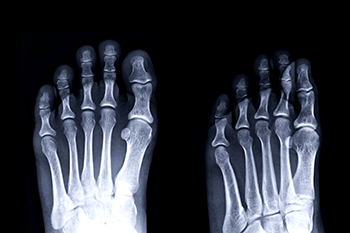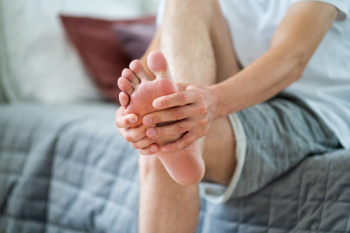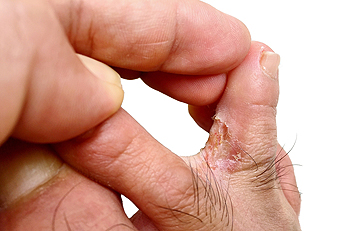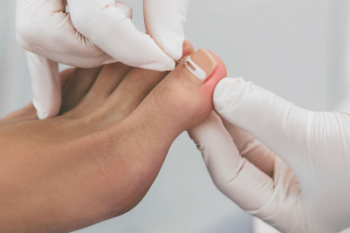Items filtered by date: February 2024
Stress Fracture Signs and Causes

Stress fractures are small cracks in bones that often stem from repetitive motions. Stress fractures are common injuries among athletes, runners, or individuals with weakened bones due to poor nutrition or medical conditions. Symptoms of stress fractures include enduring pain during physical activity, tenderness, and mild swelling that primarily occurs in the lower leg and foot. Diagnosis of stress fractures can be elusive as an X-ray may be unable to detect the hairline cracks in the bones. In those cases, a podiatrist can employ an MRI or a bone scan for confirmation. Treatment typically entails rest, immobilization using casts or braces, and, in rare instances, surgery. Early detection and intervention can help to avert further complications and ensure a smoother recovery process. If you believe you may have developed stress fractures in your feet, it is suggested that you make an appointment with a podiatrist for thorough testing and treatment options.
Activities where too much pressure is put on the feet can cause stress fractures. To learn more, contact Gabrielle Clark, DPM from LA Feet Foot & Ankle Center, Inc. Our doctor can provide the care you need to keep your pain free and on your feet.
Dealing with Stress Fractures of the Foot and Ankle
Stress fractures occur in the foot and ankle when muscles in these areas weaken from too much or too little use. The feet and ankles then lose support when walking or running from the impact of the ground. Since there is no protection, the bones receive the full impact of each step. Stress on the feet can cause cracks to form in the bones, thus creating stress fractures.
What Are Stress Fractures?
Stress fractures occur frequently in individuals whose daily activities cause great impact on the feet and ankles. Stress factors are most common among:
- Runners
- People affected with Osteoporosis
- Tennis or basketball players
- Gymnasts
- High impact workouts
Symptoms
Pain from the fractures occur in the area of the fractures and can be constant or intermittent. It will often cause sharp or dull pain with swelling and tenderness. Engaging in any kind of activity which involves high impact will aggravate pain.
If you have any questions please feel free to contact our offices located in New Orleans, and Metairie, LA . We offer the newest diagnostic and treatment technologies for all your foot and ankle needs.
Let Us Treat Your Feet This Winter
Understanding the Sensation of Gout Pain

Gout pain, a form of inflammatory arthritis, manifests as intense discomfort characterized by sudden, severe joint pain, typically affecting the big toe. Described as excruciating, stabbing, or throbbing, gout pain often strikes unexpectedly and can be debilitating, making even the slightest movement agonizing. The affected joint becomes swollen, tender, and warm to the touch, with the pain reaching its peak within a few hours. Gout attacks frequently occur at night, disrupting sleep and causing considerable distress. Beyond the big toe, gout can also affect joints such as the ankles, knees, wrists, and fingers, causing similar symptoms. The pain associated with gout can persist for days or weeks, gradually subsiding with proper treatment and management. Factors like diet, lifestyle choices, genetics, and underlying health conditions can influence the frequency and severity of gout attacks. Recognizing the distinct sensation of gout pain is essential for timely diagnosis and effective management. If you have had one or more gout attacks, it is suggested that you are under the care of a podiatrist who can help you manage this condition.
Gout is a foot condition that requires certain treatment and care. If you are seeking treatment, contact Gabrielle Clark, DPM from LA Feet Foot & Ankle Center, Inc. Our doctor will treat your foot and ankle needs.
What Is Gout?
Gout is a type of arthritis caused by a buildup of uric acid in the bloodstream. It often develops in the foot, especially the big toe area, although it can manifest in other parts of the body as well. Gout can make walking and standing very painful and is especially common in diabetics and the obese.
People typically get gout because of a poor diet. Genetic predisposition is also a factor. The children of parents who have had gout frequently have a chance of developing it themselves.
Gout can easily be identified by redness and inflammation of the big toe and the surrounding areas of the foot. Other symptoms include extreme fatigue, joint pain, and running high fevers. Sometimes corticosteroid drugs can be prescribed to treat gout, but the best way to combat this disease is to get more exercise and eat a better diet.
If you have any questions please feel free to contact our offices located in New Orleans, and Metairie, LA . We offer the newest diagnostic and treatment technologies for all your foot and ankle needs.
Hygiene and Athlete’s Foot

Athlete's foot, or tinea pedis, is a common fungal skin infection primarily affecting the feet. It presents with symptoms such as itching, peeling, and cracking, often occurring on the soles of the feet and between the toes. This contagious infection spreads through contact with contaminated surfaces, making environments like swimming pools and locker rooms potential hotspots. Wearing tight-fitting shoes exacerbates the issue by creating a moist environment conducive to fungal growth. Athlete's foot can manifest differently, such as toe web infections, moccasin-type infections, or vesicular infections. Diagnosis generally relies on visual examination, but sometimes skin or nail samples are tested for fungi. Adequate foot hygiene, including keeping feet clean and dry, changing socks daily, and wearing breathable shoes, plays a vital role in prevention and management. Medication is often prescribed for a successful recovery, and it is beneficial to complete the full course, even after symptoms subside. It is suggested for Individuals with diabetes or persistent infections to schedule an appointment with a podiatrist for more advanced care.
Athlete’s foot is an inconvenient condition that can be easily reduced with the proper treatment. If you have any concerns about your feet and ankles, contact Gabrielle Clark, DPM from LA Feet Foot & Ankle Center, Inc. Our doctor will treat your foot and ankle needs.
Athlete’s Foot: The Sole Story
Athlete's foot, also known as tinea pedis, can be an extremely contagious foot infection. It is commonly contracted in public changing areas and bathrooms, dormitory style living quarters, around locker rooms and public swimming pools, or anywhere your feet often come into contact with other people.
Solutions to Combat Athlete’s Foot
- Hydrate your feet by using lotion
- Exfoliate
- Buff off nails
- Use of anti-fungal products
- Examine your feet and visit your doctor if any suspicious blisters or cuts develop
Athlete’s foot can cause many irritating symptoms such as dry and flaking skin, itching, and redness. Some more severe symptoms can include bleeding and cracked skin, intense itching and burning, and even pain when walking. In the worst cases, Athlete’s foot can cause blistering as well. Speak to your podiatrist for a better understanding of the different causes of Athlete’s foot, as well as help in determining which treatment options are best for you.
If you have any questions please feel free to contact our offices located in New Orleans, and Metairie, LA . We offer the newest diagnostic and treatment technologies for all your foot and ankle needs.
Definition of Partial and Total Nail Avulsion

When grappling with the discomfort of ingrown toenails, partial and total nail avulsion emerges as a viable solution. Partial nail avulsion involves the removal of a portion of the affected nail, addressing the ingrown edge, and providing relief. This procedure aims to eliminate the problematic segment while preserving the overall integrity of the nail. Conversely, total nail avulsion involves completely removing the toenail, offering a more comprehensive approach to severe or recurrent ingrown toenails. Both procedures are typically performed under local anesthesia to minimize discomfort. Proper postoperative care is vital to promote healing and prevent complications following avulsion. Understanding the differences between partial and total nail avulsion allows individuals to make informed decisions in collaboration with podiatrists. If you have developed an ingrown toenail, it is strongly suggested that you are under the care of a podiatrist who can determine if one of these types of surgery is right for you.
Ingrown toenails may initially present themselves as a minor discomfort, but they may progress into an infection in the skin without proper treatment. For more information about ingrown toenails, contact Gabrielle Clark, DPM of LA Feet Foot & Ankle Center, Inc. Our doctor can provide the care you need to keep you pain-free and on your feet.
Ingrown Toenails
Ingrown toenails are caused when the corner or side of a toenail grows into the soft flesh surrounding it. They often result in redness, swelling, pain, and in some cases, infection. This condition typically affects the big toe and may recur if it is not treated properly.
Causes
- Improper toenail trimming
- Genetics
- Improper shoe fitting
- Injury from pedicures or nail picking
- Abnormal gait
- Poor hygiene
You are more likely to develop an ingrown toenail if you are obese, have diabetes, arthritis, or have any fungal infection in your nails. Additionally, people who have foot or toe deformities are at a higher risk of developing an ingrown toenail.
Symptoms
Some symptoms of ingrown toenails are redness, swelling, and pain. In rare cases, there may be a yellowish drainage coming from the nail.
Treatment
Ignoring an ingrown toenail can have serious complications. Infections of the nail border can progress to a deeper soft-tissue infection, which can then turn into a bone infection. You should always speak with your podiatrist if you suspect you have an ingrown toenail, especially if you have diabetes or poor circulation.
If you have any questions, please feel free to contact our offices located in New Orleans, and Metairie, LA . We offer the newest diagnostic and treatment technologies for all your foot care needs.

